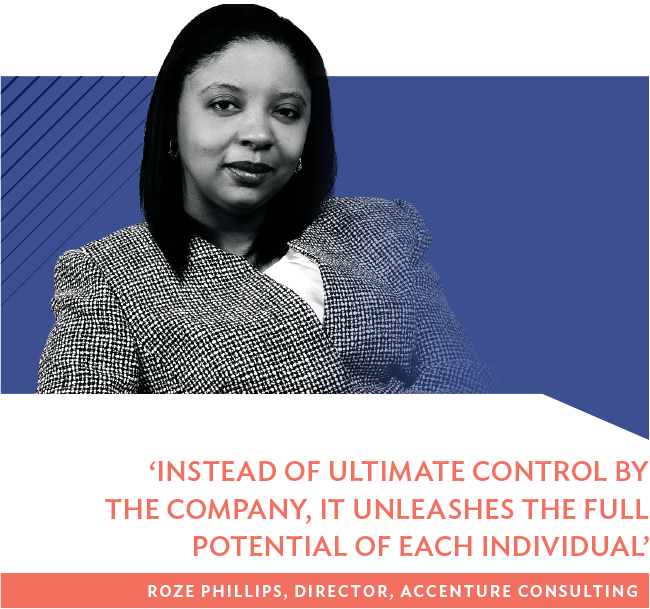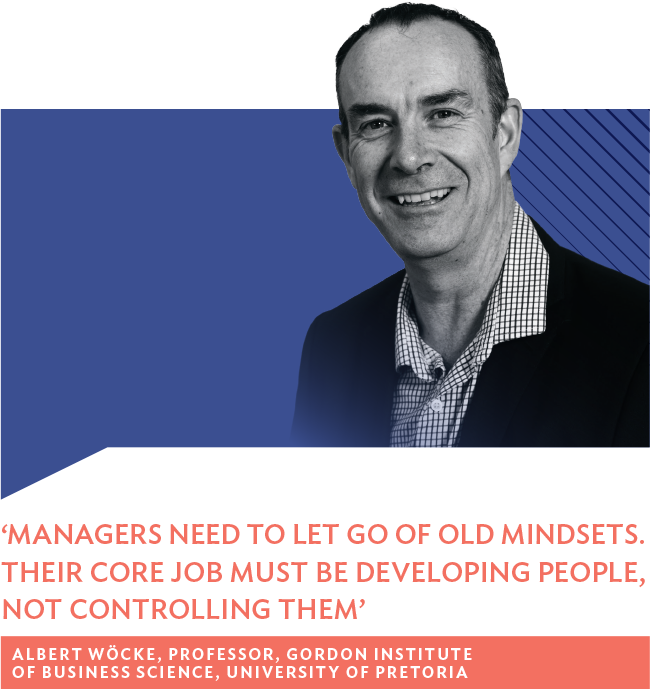Goodbye ‘rank and yank’, hello personal feedback. Big corporates are increasingly abolishing annual performance appraisals and employee ratings in favour of frequent, informal feedback between managers and employees. Some companies have gone entirely numberless in their performance management (PM) and allocate merit pay increases based on these regular one-on-one conversations.
It’s all about looking forwards not backwards – creating an individual assessment tool instead of one-size-fits-all in order to develop employees for the future rather than evaluating their past performances. ‘I don’t think sticking with the old performance management system is even an option,’ says Albert Wöcke, a full-time professor at the University of Pretoria’s Gordon Institute of Business Science (GIBS).
‘The forced ranking system in particular is over. It’s old-fashioned, redundant HR, which doesn’t have a place in a modern organisation. If you’re still applying General Electric’s Vitality Curve, you are – so to speak – well behind the curve.’
Also known as ‘rank and yank’ or forced ranking, the curve grades the individual productivity of a workforce and ranks employees against each other. Those at the bottom end of the curve tend to get fired (‘yanked’).
Traditionally, performance is assessed using hard measures (which are quantitative and include targets regarding profit, sales and other numerical outputs) and soft measures (which are qualitative and refer to behaviour and service levels).
In SA, common appraisal methods include 360-degree feedback, which gives a full profile of an employee, usually by their co-workers, and evaluates developmental gaps and differences in values; and management by objective, which requires the manager and employee to agree on specific targets and then measures whether these have been achieved within a set time frame.
Wöcke says the annual review has been ‘massively over-engineered’ and has a legitimacy problem. He explains that the moderation process, in which line managers evaluate their subordinates against a list of criteria, is biased. ‘There’s a trade-off as they opt out from having tough conversations with their staff. For example, a CEO will generally give his or her PA a high rating regardless of performance, because to the CEO a good working relationship is more valuable than an honest appraisal. But as a result, the company’s HR information system doesn’t receive accurate information about who is a high-performer and who is not and cannot make appropriate decisions on pay, development or promotion.’ Unsurprisingly, the dissatisfaction with the ‘old’ way is high across all job levels.

A widely quoted study by services firm CEB, now Gartner, found that US managers spend on average 210 hours or nearly five weeks per year on appraisals. Another study (by advisory firm Willis Tower Watson) revealed that 45% of managers did not see value in their systems.
At GIBS, Wöcke opens his classes on PM by asking his MBA and executive students whether they have a PM system in their organisation.
‘Usually about 95% of the people in the room raise their hands,’ he says. ‘The next question I ask is, “Who is happy with their system?”. Suddenly only about 15% raise their hands – and those are usually HR professionals. This has been consistent for the past 15 years.’
Vivian Kaposambo, who last year submitted an MPhil thesis on employee perception of performance appraisal and its relationship with organisational commitment at the University of Cape Town, confirms that employees generally find their appraisal unfair, which hampers other areas of their work.
‘In ensuring that PM is a process that attains the right outcomes, organisations need to ensure that the process is fair and transparent and that there is acceptance from the employees,’ she says. ‘The perception of unfairness within the PM system can adversely affect employees’ organi-sational commitment, job satisfaction, trust in management and their performance at work.’
Scrapping the annual performance review and ratings alone won’t fix this. A complete rethink is required, or as Harvard Business Review calls it, the ‘performance management revolution’.
So what’s new?
The re-invented approach is people, not company, centric. It’s individualised, more agile and happens in real time. Previously, PM used to create employees who conformed to the organisational blueprint of perfection. But this is not enough ‘in a digital world, where work is faster, more collaborative, more networked and requires ever-evolving skills, and the workforce is more diverse’, argues Roze Phillips, director: management consulting lead for sub-Saharan Africa at Accenture Consulting. She explains in a LinkedIn article how her firm’s new approach ‘is alive’ and how ‘a built-in continuous feedback loop means that employees’ growth paths are constantly refined’.
She writes: ‘PM in a digital world is all about personalisation. It’s going to require customisation of coaching, feedback, goal setting, rewards and com-pensation based on the needs of each employee or workforce segment. It will place more decision-making power in the hands of employees and leaders. Instead of ultimate control by the company, it unleashes the full potential of each individual. This element is critical to support a workforce that must evolve daily – acquiring new skills rapidly and embracing diversity and collaboration to achieve high performance – to remain relevant.’
This trend is not a flash in the pan, because it’s driven by business needs instead of being imposed by HR, according to Harvard Business Review. The authors recap how tech firms such as Adobe, Dell, Microsoft and IBM have led the ‘performance management revolution’ by ditching annual reviews. Next came professional services firms – Deloitte, Accenture and PwC – and early adopters in other industries such as fashion brand Gap as well as GE, which ironically used to be ‘the long-time role model for traditional appraisals’. The move from the traditional PM system to the reinvented one requires massive organisational intervention, says Wöcke. ‘Managers need to let go of old mindsets. Their core job must be developing people, not controlling them. Otherwise you can’t scale and can’t change.

‘Setting up the new PM is initially difficult because we’re still learning about the exact mechanics. Such a system normally takes at least two cycles before we understand the ins and outs. At this stage, we’re still feeling our way forwards. Because of the complexity, we’ll only have a clear picture within the next three to four years.’
Companies need to ensure that their systems take the cultural diversity of SA’s workforce into account, says Ameeta Jaga, an organisational psychologist and senior lecturer at the UCT School of Management Studies. ‘The PM systems that we see in SA organisations are mostly based on the ideas of rewarding individual performance and that there are egalitarian relationships between employee and manager in the workplace for these participative goal development and conversations to take place – these ideas are based on Anglo cultural values.
‘This doesn’t take into consideration the cultural values of many black employees where there’s greater value for achievement to satisfy collective goals or needs, and high power distance characterises the employee-manager relationship. So organisations could start rethinking the design of PM systems in a South African context with some of these points in mind.’
However, in certain sectors, notably sales and manufacturing, management by objectives is likely to remain relevant in the near future. These are jobs that will continue to be heavily driven by numbers and incentives, says Wöcke. However, the overall HR and business landscape is changing dramatically and at great speed. ‘The Fourth Industrial Revolution is shaking us up extremely hard, and with it there will be completely new jobs and new forms of organisations,’ he adds. ‘You can be confident that most jobs will look different in the next five years because of technology, which makes the reinvention of PM systems and individualised development even more urgent.’
Perhaps Phillips gives the best insight into the future when presenting herself as a living example of Accenture’s reinvented PM programme. ‘It allowed me to recalibrate my journey – handing me a ticket to an altogether more desirable place.This job combines my obsession with the future and my need to achieve with my view of the world as my eternal classroom. It suits me. It’s good for the business and it’s a way forward that I am fully aligned with. When you are part of shaping and creating the new, you cannot help but be excited.’
If that’s what happens when companies say goodbye to once-a-year 360-degree feedback and ‘rank and yank’ curves to welcome new ideas, we can look forward to a more engaged, motivated workforce that is eager to innovate and fuel the companies of the future.








